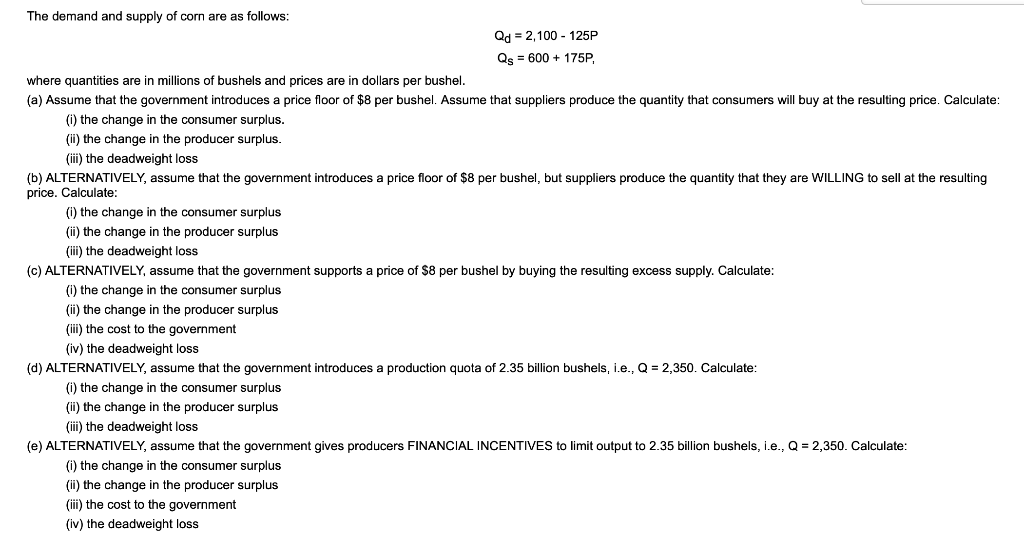The demand and supply of corn are as follows: Qd = 2,100-125P Qs = 600+ 175P, where quantities are in millions of bushels and prices are in dollars per bushel. (a) Assume that the government introduces a price floor of $8 per bushel. Assume that suppliers produce the quantity that consumers will buy at the resulting price. Calculate: (i) the change in the consumer surplus. (ii) the change in the producer surplus. (iii) the deadweight loss (b) ALTERNATIVELY, assume that the government introduces a price floor of $8 per bushel, but suppliers produce the quantity that they are WILLING to sell at the resulting price. Calculate: (i) the change in the consumer surplus (ii) the change in the producer surplus (iii) the deadweight loss (c) ALTERNATIVELY, assume that the government supports a price of $8 per bushel by buying the resulting excess supply. Calculate:
The demand and supply of corn are as follows: Qd = 2,100-125P Qs = 600+ 175P, where quantities are in millions of bushels and prices are in dollars per bushel. (a) Assume that the government introduces a price floor of $8 per bushel. Assume that suppliers produce the quantity that consumers will buy at the resulting price. Calculate: (i) the change in the consumer surplus. (ii) the change in the producer surplus. (iii) the deadweight loss (b) ALTERNATIVELY, assume that the government introduces a price floor of $8 per bushel, but suppliers produce the quantity that they are WILLING to sell at the resulting price. Calculate: (i) the change in the consumer surplus (ii) the change in the producer surplus (iii) the deadweight loss (c) ALTERNATIVELY, assume that the government supports a price of $8 per bushel by buying the resulting excess supply. Calculate:
Microeconomics A Contemporary Intro
10th Edition
ISBN:9781285635101
Author:MCEACHERN
Publisher:MCEACHERN
Chapter16: Public Goods And Public Choice
Section: Chapter Questions
Problem 14PAE
Related questions
Question
D2

Transcribed Image Text:The demand and supply of corn are as follows:
Qd = 2,100 - 125P
Qs = 600 + 175P,
where quantities are in millions of bushels and prices are in dollars per bushel.
(a) Assume that the government introduces a price floor of $8 per bushel. Assume that suppliers produce the quantity that consumers will buy at the resulting price. Calculate:
(i) the change in the consumer surplus.
(ii) the change in the producer surplus.
(iii) the deadweight loss
(b) ALTERNATIVELY, assume that the government introduces a price floor of $8 per bushel, but suppliers produce the quantity that they are WILLING to sell at the resulting
price. Calculate:
(i) the change in the consumer surplus
(ii) the change in the producer surplus
(iii) the deadweight loss
(c) ALTERNATIVELY, assume that the government supports
price of $8 per bushel by buying the resulting excess supply. Calculate:
() the change in the consumer surplus
(i) the change in the producer surplus
(i) the cost to the government
(iv) the deadweight loss
(d) ALTERNATIVELY, assume that the government introduces a production quota of 2.35 billion bushels, i.e., Q = 2,350. Calculate:
(i) the change in the consumer surplus
(ii) the change in the producer surplus
(iii) the deadweight loss
(e) ALTERNATIVELY, assume that the government gives producers FINANCIAL INCENTIVES to limit output to 2.35 billion bushels, i.e., Q = 2,350. Calculate:
(i) the change in the consumer surplus
(ii) the change in the producer surplus
(iii) the cost to the government
(iv) the deadweight loss
Expert Solution
This question has been solved!
Explore an expertly crafted, step-by-step solution for a thorough understanding of key concepts.
This is a popular solution!
Trending now
This is a popular solution!
Step by step
Solved in 5 steps

Knowledge Booster
Learn more about
Need a deep-dive on the concept behind this application? Look no further. Learn more about this topic, economics and related others by exploring similar questions and additional content below.Recommended textbooks for you


Managerial Economics: A Problem Solving Approach
Economics
ISBN:
9781337106665
Author:
Luke M. Froeb, Brian T. McCann, Michael R. Ward, Mike Shor
Publisher:
Cengage Learning



Managerial Economics: A Problem Solving Approach
Economics
ISBN:
9781337106665
Author:
Luke M. Froeb, Brian T. McCann, Michael R. Ward, Mike Shor
Publisher:
Cengage Learning



